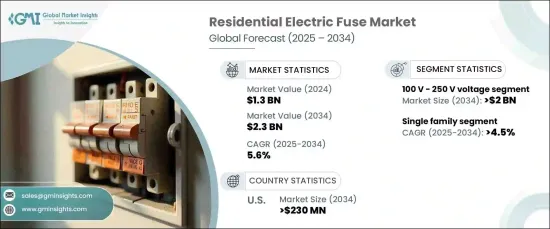 |
市場調查報告書
商品編碼
1666968
住宅電保險絲市場機會、成長動力、產業趨勢分析與 2025 - 2034 年預測Residential Electric Fuse Market Opportunity, Growth Drivers, Industry Trend Analysis, and Forecast 2025 - 2034 |
||||||
2024 年全球住宅電保險絲市場規模達到 13 億美元,預計到 2034 年將以 5.6% 的強勁複合年成長率成長。對能源效率和加強安全措施的重視進一步增強了市場的潛力。

最佳化電力消耗的努力正在促使屋主和政府對電力系統進行現代化改造。現代電保險絲處於最前沿,在改善能源利用和確保家庭安全方面發揮著至關重要的作用。保險絲技術的創新,包括先進的材料和尖端的故障檢測功能,顯著提高了住宅電氣系統的安全性和效率,進一步推動了市場的發展。
| 市場範圍 | |
|---|---|
| 起始年份 | 2024 |
| 預測年份 | 2025-2034 |
| 起始值 | 13億美元 |
| 預測值 | 23億美元 |
| 複合年成長率 | 5.6% |
預計到 2034 年,100 V - 250 V 電壓段的收入將超過 20 億美元。此外,太陽能電池板等再生能源解決方案的日益普及凸顯了對強大的電氣保護系統的迫切需求。對安全性、成本節約和智慧家庭自動化系統的廣泛整合的高度關注進一步推動了該領域對現代保險絲的需求。
受城市化進程加快和新房屋需求激增的推動,預計到 2034 年,獨戶住宅市場將實現 4.5% 的穩定複合年成長率。獨戶住宅建設的繁榮為先進電力基礎設施的發展提供了重大機會。隨著住宅建築安全標準和法規的嚴格實施,智慧家庭技術的採用不斷增加,從而增加了對尖端電路保護設備的需求。由於屋主尋求保護家用電器和電氣系統,這一趨勢正在重塑家用電保險絲市場。
在美國,住宅電保險絲市場規模預計到 2034 年將超過 2.3 億美元。在法規、安全運動和對電氣危險的擔憂的推動下,消費者對電氣安全的認知不斷提高,推動了先進保險絲技術的採用。
目錄
第 1 章:方法論與範圍
- 市場定義
- 基礎估算與計算
- 預測計算
- 資料來源
- 基本的
- 次要
- 有薪資的
- 民眾
第 2 章:執行摘要
第 3 章:產業洞察
- 產業生態系統分析
- 監管格局
- 產業衝擊力
- 成長動力
- 產業陷阱與挑戰
- 成長潛力分析
- 波特的分析
- 供應商的議價能力
- 買家的議價能力
- 新進入者的威脅
- 替代品的威脅
- PESTEL 分析
第4章:競爭格局
- 介紹
- 戰略儀表板
- 創新與永續發展格局
第 5 章:市場規模與預測:按電壓,2021 – 2034 年
- 主要趨勢
- < 100 伏
- 100 伏 - 250 伏
第 6 章:市場規模與預測:按應用,2021 – 2034 年
- 主要趨勢
- 單親家庭
- 多戶家庭
第 7 章:市場規模及預測:按地區,2021 – 2034 年
- 主要趨勢
- 北美洲
- 美國
- 加拿大
- 墨西哥
- 歐洲
- 英國
- 法國
- 德國
- 義大利
- 荷蘭
- 亞太地區
- 中國
- 日本
- 印度
- 韓國
- 中東和非洲
- 沙烏地阿拉伯
- 阿拉伯聯合大公國
- 科威特
- 土耳其
- 拉丁美洲
- 巴西
- 阿根廷
第8章:公司簡介
- Bel Fuse
- Denco
- Eaton
- Efen
- Fuji Electric
- Fuseco
- KYOCERA AVX
- Legrand
- Littelfuse
- McGraw Edison
- Mersen
- Optifuse
- Schurter
- Siba
- Siemens
The Global Residential Electric Fuse Market reached USD 1.3 billion in 2024 and is projected to grow at a robust CAGR of 5.6% through 2034. This growth trajectory is fueled by the rapid expansion of residential infrastructure, driven by accelerating urbanization, population increases, and rising electricity demand. The emphasis on energy efficiency and enhanced safety measures further strengthens the market's potential.

Efforts to optimize electricity consumption are prompting homeowners and governments to modernize electrical systems. Modern electric fuses are at the forefront, playing a vital role in improving energy use and ensuring household safety. Innovations in fuse technology, including advanced materials and cutting-edge fault detection features, are significantly enhancing the safety and efficiency of residential electrical systems, further propelling the market.
| Market Scope | |
|---|---|
| Start Year | 2024 |
| Forecast Year | 2025-2034 |
| Start Value | $1.3 Billion |
| Forecast Value | $2.3 Billion |
| CAGR | 5.6% |
The 100 V - 250 V voltage segment is expected to generate over USD 2 billion by 2034. This surge is attributed to the integration of energy-efficient, low-voltage systems in residential construction, which demand reliable protective components. Additionally, the growing adoption of renewable energy solutions like solar panels underscores the critical need for robust electrical protection systems. Heightened focus on safety, cost savings, and the widespread integration of smart home automation systems are further driving demand for modern fuses in this segment.
The single-family housing market segment is expected to experience a steady CAGR of 4.5% through 2034, fueled by increased urbanization and surging demand for new homes. The boom in single-family home construction presents significant opportunities for advanced electrical infrastructure development. With strict safety standards and regulations governing residential buildings, the adoption of smart home technologies continues to rise, bolstering the demand for cutting-edge circuit protection devices. This trend is reshaping the residential electric fuse market as homeowners seek to safeguard appliances and electrical systems.
In the U.S., the residential electric fuse market is expected to exceed USD 230 million by 2034. The combination of growing urbanization, expanding residential construction activities, and retrofitting older homes to meet modern energy efficiency and safety standards is fueling this growth. Consumer awareness regarding electrical safety, spurred by regulations, safety campaigns, and concerns over electrical hazards, is driving the adoption of advanced fuse technologies.
Table of Contents
Chapter 1 Methodology & Scope
- 1.1 Market definitions
- 1.2 Base estimates & calculations
- 1.3 Forecast calculation
- 1.4 Data sources
- 1.4.1 Primary
- 1.4.2 Secondary
- 1.4.2.1 Paid
- 1.4.2.2 Public
Chapter 2 Executive Summary
- 2.1 Industry synopsis, 2021 - 2034
Chapter 3 Industry Insights
- 3.1 Industry ecosystem analysis
- 3.2 Regulatory landscape
- 3.3 Industry impact forces
- 3.3.1 Growth drivers
- 3.3.2 Industry pitfalls & challenges
- 3.4 Growth potential analysis
- 3.5 Porter's analysis
- 3.5.1 Bargaining power of suppliers
- 3.5.2 Bargaining power of buyers
- 3.5.3 Threat of new entrants
- 3.5.4 Threat of substitutes
- 3.6 PESTEL analysis
Chapter 4 Competitive Landscape, 2024
- 4.1 Introduction
- 4.2 Strategic dashboard
- 4.3 Innovation & sustainability landscape
Chapter 5 Market Size and Forecast, By Voltage, 2021 – 2034 (USD Million, ‘000 Units)
- 5.1 Key trends
- 5.2 < 100 V
- 5.3 100 V - 250 V
Chapter 6 Market Size and Forecast, By Application, 2021 – 2034 (USD Million, ‘000 Units)
- 6.1 Key trends
- 6.2 Single family
- 6.3 Multi family
Chapter 7 Market Size and Forecast, By Region, 2021 – 2034 (USD Million, ‘000 Units)
- 7.1 Key trends
- 7.2 North America
- 7.2.1 U.S
- 7.2.2 Canada
- 7.2.3 Mexico
- 7.3 Europe
- 7.3.1 UK
- 7.3.2 France
- 7.3.3 Germany
- 7.3.4 Italy
- 7.3.5 Netherlands
- 7.4 Asia Pacific
- 7.4.1 China
- 7.4.2 Japan
- 7.4.3 India
- 7.4.4 South Korea
- 7.5 Middle East & Africa
- 7.5.1 Saudi Arabia
- 7.5.2 UAE
- 7.5.3 Kuwait
- 7.5.4 Turkey
- 7.6 Latin America
- 7.6.1 Brazil
- 7.6.2 Argentina
Chapter 8 Company Profiles
- 8.1 Bel Fuse
- 8.2 Denco
- 8.3 Eaton
- 8.4 Efen
- 8.5 Fuji Electric
- 8.6 Fuseco
- 8.7 KYOCERA AVX
- 8.8 Legrand
- 8.9 Littelfuse
- 8.10 McGraw Edison
- 8.11 Mersen
- 8.12 Optifuse
- 8.13 Schurter
- 8.14 Siba
- 8.15 Siemens









